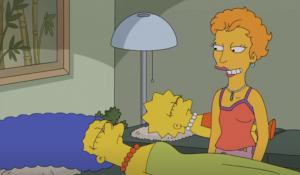'The Simpsons' Spotlights Breast Cancer Treatment
- For Breast Cancer Awareness Month, The Simpsons featured a character who’s a breast cancer survivor who had a unilateral mastectomy and chemotherapy.
- After going through breast cancer, it can take some survivors time to find their footing again when it comes to self-love; embracing your whole self after cancer treatment is vital. Psychologists and therapists are helpful resources for when you’re struggling to cope.
- A mastectomy is used to treat breast cancer; it refers to the full or partial surgical removal of one or both breasts. A unilateral mastectomy is the removal of one breast.
Cartoon character Dr. Wendy Sage is voiced by real-life breast cancer survivor, Renee Ridgeley. Dr. Sage is a hypnotherapist and a survivor who treated her cancer with a unilateral mastectomy as well as chemotherapy.
Read More Dr. Sage’s chest shows a visible scar from a port-o-cath which is used to administer chemotherapy. Ridgeley is the wife of Simpson’s showrunner Matt Selman. Related: Blink 182's Mark Hoppus Shares Before & After Pictures from 'Surgery to Remove My Chemo Port'; What is a Chemo Port?
Dr. Sage’s chest shows a visible scar from a port-o-cath which is used to administer chemotherapy. Ridgeley is the wife of Simpson’s showrunner Matt Selman. Related: Blink 182's Mark Hoppus Shares Before & After Pictures from 'Surgery to Remove My Chemo Port'; What is a Chemo Port?On Twitter, the proud partner Selman writes, “My wife @ReneeRidgeley voices @TheSimpsons Dr. Sage, a hypnotherapist who happens to be a one-breasted cancer survivor who employs cutting-edge holistic techniques as well as Doctor Mysterio’s Mesmerific Hypno-wheel.”
My wife @ReneeRidgeley voices @TheSimpsons Dr. Sage, a hypnotherapist who happens to be a one-breasted cancer survivor — who employs cutting-edge holistic techniques as well as Doctor Mysterio's Mesmerific Hypno-wheel pic.twitter.com/ti4HEIvEZc
— Matt Selman (@mattselman) October 25, 2021
The Simpsons has continued to churn out witty, topical (and sometimes frighteningly accurate) storylines for over three decades. By making the choice to feature a breast cancer survivor who did not have reconstructive surgery after her mastectomy, The Simpsons is helping the world see survivors in a new, more accepting light.

How to Love Your Body After Breast Cancer
For people who have a mastectomy as part of their breast cancer treatment, some may find that it alters their sense of self. Additionally, the effects of chemotherapy, such as hair loss, can also impact how you view yourself. This said, it’s important to embrace steadfast self-love, even alongside your changing look.
Related: Complete Guide to Wigs for Cancer Patients: Cost, Types and Where to Buy
If you’re struggling to practice self-love during or post-cancer treatment, speak with a psychologist or therapist who can utilize intervention techniques like cognitive behavioral therapy to help you challenge negative thoughts you may have about yourself or your body.
As The Simpsons’ Dr. Sage proves: By showing up fully as yourself and embracing the way you look, you open the door to not only greater self-love, but you may positively impact others, too.
Sex After Cancer: How Women Can Connect the Body & Mind and Find the Right Products
What is a Unilateral Mastectomy?
A mastectomy is a type of treatment for breast cancer that involves the full or partial surgical removal of one or both breasts. A unilateral mastectomy refers to the removal of one breast.
Some people may opt to have reconstructive surgery following a mastectomy. In an earlier interview, Dr. Andrea Pusic, the chief of plastic surgery at Brigham and Women’s Hospital, speaks with SurvivorNet about helping women feel good after they’ve been through breast cancer. “So I perform primarily reconstructive surgery on patients who’ve had breast cancer and perform their reconstruction,” she says.
“So effectively when a woman has breast cancer, not all women need to have a mastectomy,” explains Dr. Pusic. “But when the doctor does recommend a mastectomy, then a woman needs to understand her options for breast reconstruction. So the goal of that first meeting is to help her feel comfortable, to get to know our team, for us to get to know her, and then to start to lay out the options in a way that’s easy to understand.”
Dr. Pusic explains the benefits of immediate reconstruction, directly following the mastectomy, versus delayed reconstruction later on, saying, “In terms of the benefits of, say, immediate reconstruction is that a woman goes through that process all at once, and there is not such a lag in terms from a body image perspective of being without a breast.”
Dr. Pusic says there have been some exciting new developments around breast reconstruction. “So one of the things I, I personally think is really exciting about breast reconstruction that's happened in the last, say, 10 years, is that we've really focused on understanding the patient's voice in terms of understanding outcomes. So much about what happens, about the success of a breast reconstruction is not in the eyes of the surgeon, but it's about how women feel about how they look, what they think about [how] they look.”
“And that's giving us really great insights about key issues about what it's like to have bilateral mastectomies compared to unilateral mastectomy, one versus two, radiation or no radiation,” she says.
Dr. Andrea Pusic on Breast Reconstruction After a Mastectomy
Learn more about SurvivorNet's rigorous medical review process.


